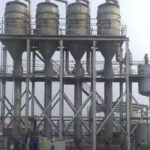- Home
- portfolio
- Exhaust Emission & Control System
- EXHAUST EMISSION AND CONTROL SYSTEM
EXHAUST EMISSION AND CONTROL SYSTEM
Exhaust Emission and Pollution Control Systems
EXHAUST EMISSION AND POLLUTION CONTROL SYSTEMS
Technological requirements, legislative pressures, and last but not least a growing environmental concern by the population at large have led to substantial improvements in particle separation from gases during the past few years.
Correctly engineered and well-maintained emission control systems have a proven record of performance for fine particle separation.
We at RAYGM offers customized emission control systems for our customer needs, truly engineered to meet legislative requirements with lowest possible CAPEX + OPEX.
Our Customised Emission Control Products include
1. Cyclone Separators
2. Bag Filter (Bag House)
3. Wet and Dry Scrubbers.
1. HIGH EFFICIENCY CYCLONES.
Cyclones provide a relatively low-cost method of removing particulate matter from exhaust gas streams. Cyclones are somewhat more complicated in design than simple gravity settling systems, and their removal efficiency is accordingly much better than that of settling chambers. Cyclones are often installed as pre-cleaners before these more effective devices.
The range of particle sizes collected in a cyclone is dependent upon the overall diameter and relative dimensions of the device. Various refinements such as the use of skimmers, turning vanes, improve efficiency. Stacking cyclones in series or in parallel can provide further alternatives for improving overall collection efficiency.
RAYGM HIGH EFFICIENCY CYCLONES DESIGN AND MANUFACTURING RANGE
Design
- Custom Designed to Customer Satisfaction
- Sturdy Designs for Long life.
- Designed for lowest Possible pressure drop.
Sizes Offered
- 10 cm to 2.5 meters
Designs Offred
- Cyclones In Series.
- Cyclones in Parallel.
- Battery of Axial Flow Cyclones.
Dust Separation Efficiency
- 98% for Particles ≥ 8 microns.
Maximum Air Quantity
- As per customer requirement.
Material
- Carbon Steel Hardox / Vautid Lined, Carbon Steel refractory lined, Carbon Steel Spray Galvanized, Stainless Steel 304, Stainless Steel 316, Stainless Steel 321, Stainless Steel 310, etc.
Features
- Requires No Expensive Filters
- Maintenance Free
- Good Recovery of Materials at lowest capital cost.
- Low Pressure Drop and power consumption
2. HIGH EFFICIENCY BAG FILTER (BAG HOUSE)
Fibrous filter media have acquired a firm place in today’s separation technology. They are the medium and technique of choice when efficient separation is required.
Dust laden air is drawn in the bag house and passed through filter media. The initial filtering phase takes place within the interior of the medium and then relocated to the surface. Thus, the filter cake deposited on the surface becomes the actual filter medium, which can reach separation efficiencies of more than 99.9 %. As the layer of dust increases the filter resistance rises. The Cleaned air exits through exhaust duct.
Dust collectors are supplied with compressed air headers, Solenoid valves and timers. With the help of timers compressed air is blown in the bags which draws surrounding air with Ventury effect in the bags giving reverse blow which disengages the dust on the filter media and gets collected at the bottom of the Bag filter, regularly discharged through and Rotary Valve or Screw conveyor.
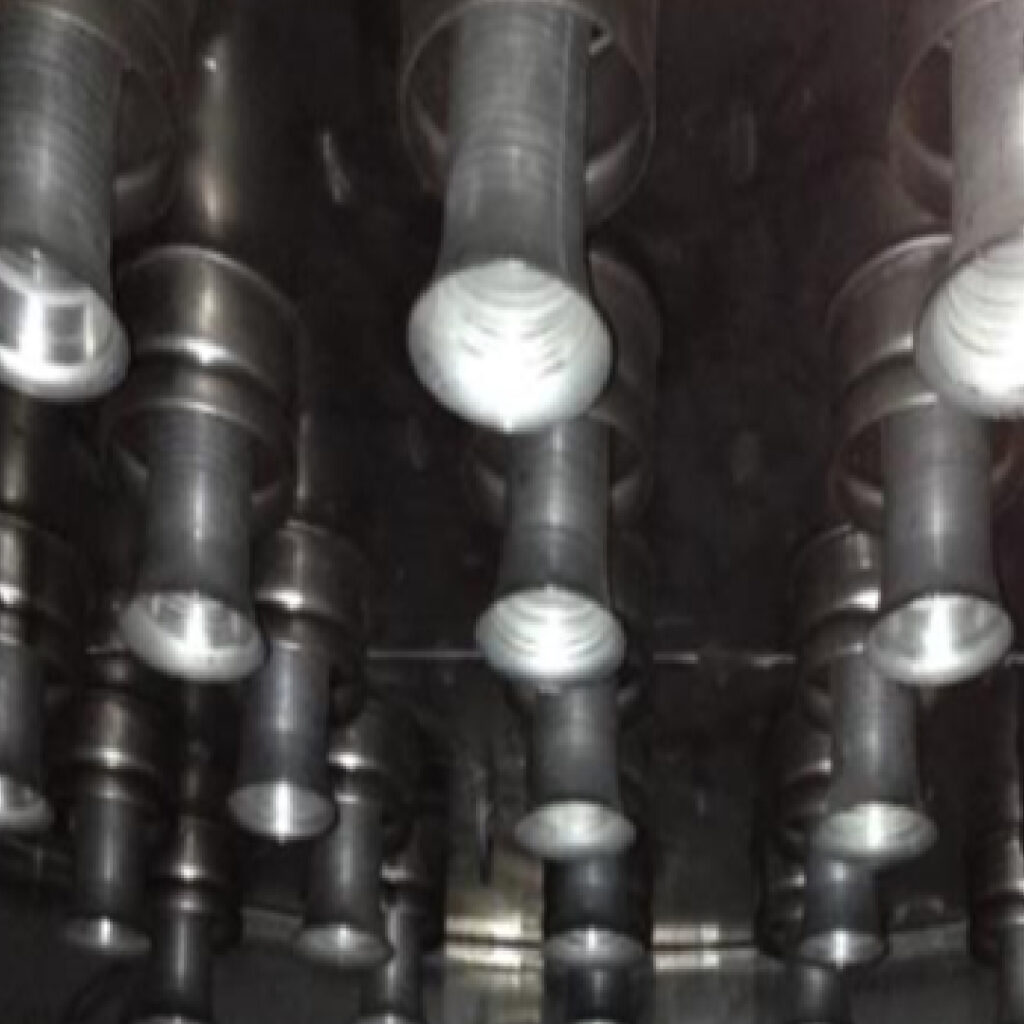
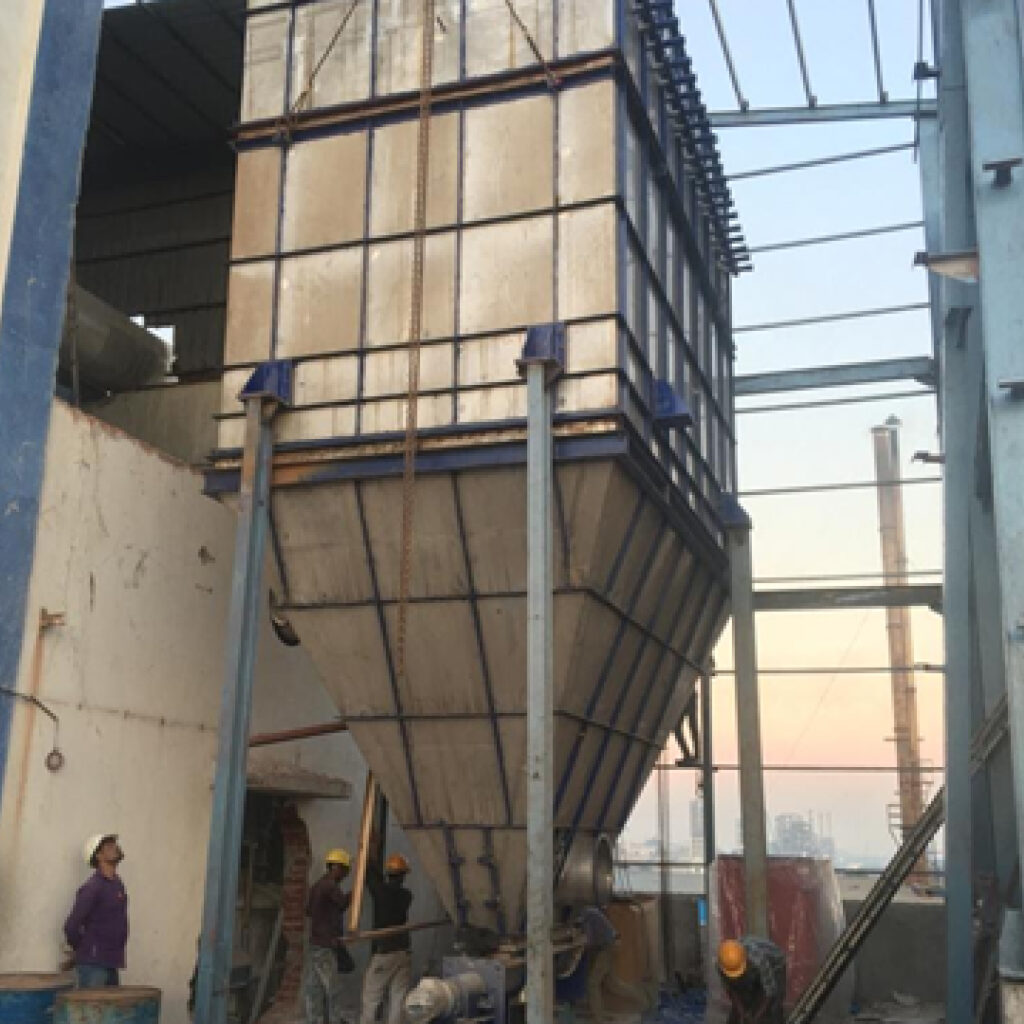
RAYGM HIGH EFFICIENCY BAG FILTER (BAG HOUSE) DESIGN AND MANUFACTURING RANGE
Design
- Custom Designed to Customer Satisfaction
- Sturdy Designs for Long life.
- Designed for lowest Possible pressure drop.
- Properly designed for various dust with proper CAN Velocity and Interstitial Velocity.
Configuration
- Rectangular (Modular) Type
- Circular type
Air Entry Designs
- Bottom Hopper Central Entry
- Tangential Entry
- Multi Entry and Exits.
Top Plenum Configuration
- Top access
- Walk through pent house
Dust Separation Efficiency
- 99% for Particles ≥ 1 microns.
- Max Emission of 20 ppm for ≤ Pm2.5 particles
Maximum Air Quantity
- As per customer requirement.
Material
- Carbon Steel Hardox / Vautid Lined, Carbon Steel refractory lined, Carbon Steel Spray Galvanized, Stainless Steel 304, Stainless Steel 316, Stainless Steel 321, Stainless Steel 310, etc.
Features
- Low Pressure Drop and power consumption
- Fully insulated and hopper heat traced designs for avoiding condensation in the hopper
- Antistatic design with proper earthing system for every bag on demand
- Installation of Fire hydrant headers for combustible dust.
- Installation of Explosion vents, flame arrestors, Chemical suppression / Isolation etc.
- Special Bags for moisture laden air, High temperature air etc.
3. SCRUBBERS
As the name scrubber implies, wet collectors or wet scrubbers are devices that use a liquid for removing particles or polluted gases from an exhaust gas stream. Water sprays can be injected into the gas stream; gas can be forced to pass through sheets or films of liquid; or, the gas can move through beds of plastic spheres covered with liquid. Each of these techniques can effectively remove particulate matter from process exhaust gases. They can also effectively remove gases such as particulate matters, HCl, SO2 etc.
- Roto-Vane scrubber with no moving parts
- Dynamic Mechanically assisted scrubbers.
- High efficiency adjustable venturi scrubber
- Multi-venturi scrubber
- Packed towers for gas absorption, odour control.
- Self-Priming Venturi Scrubbers.
- Volatile Organics Condensing and Coalescing Scrubber.
- Aerodynamic Dry Scrubbers.
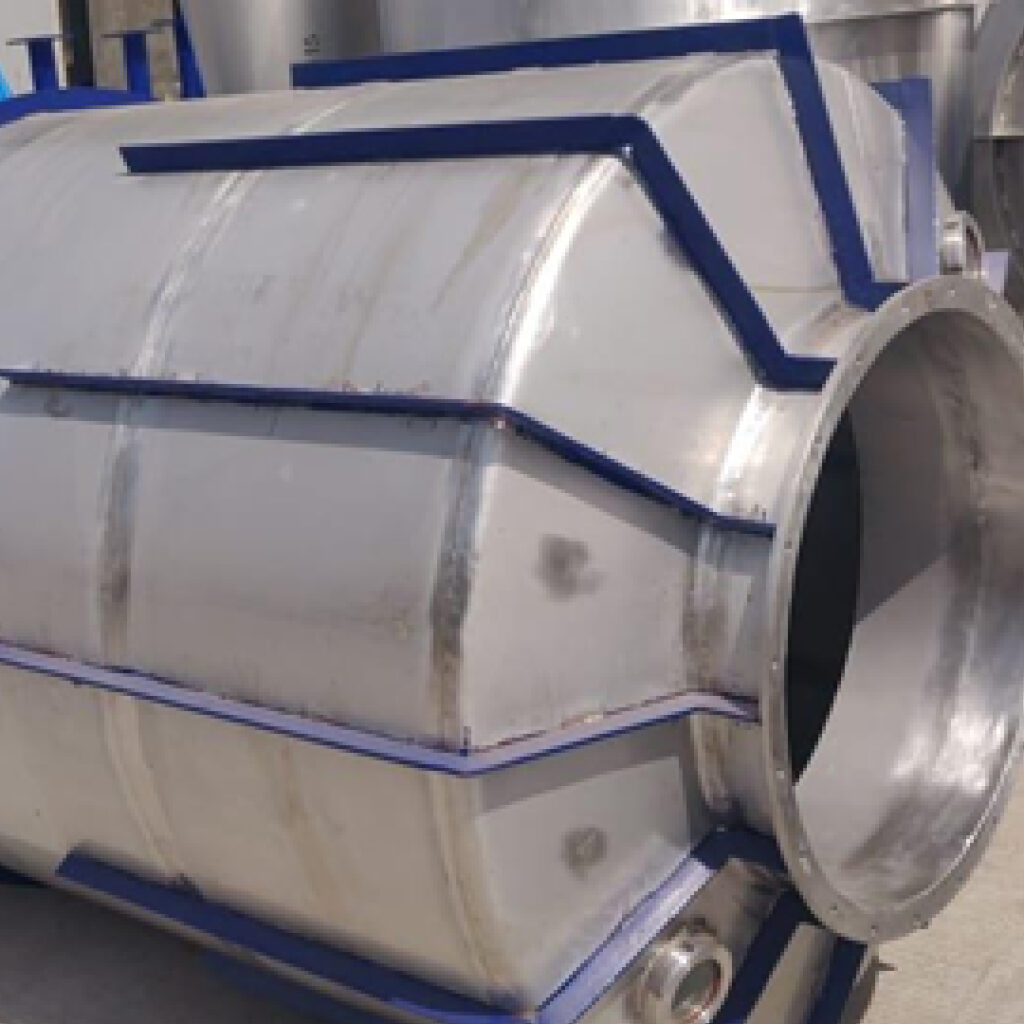
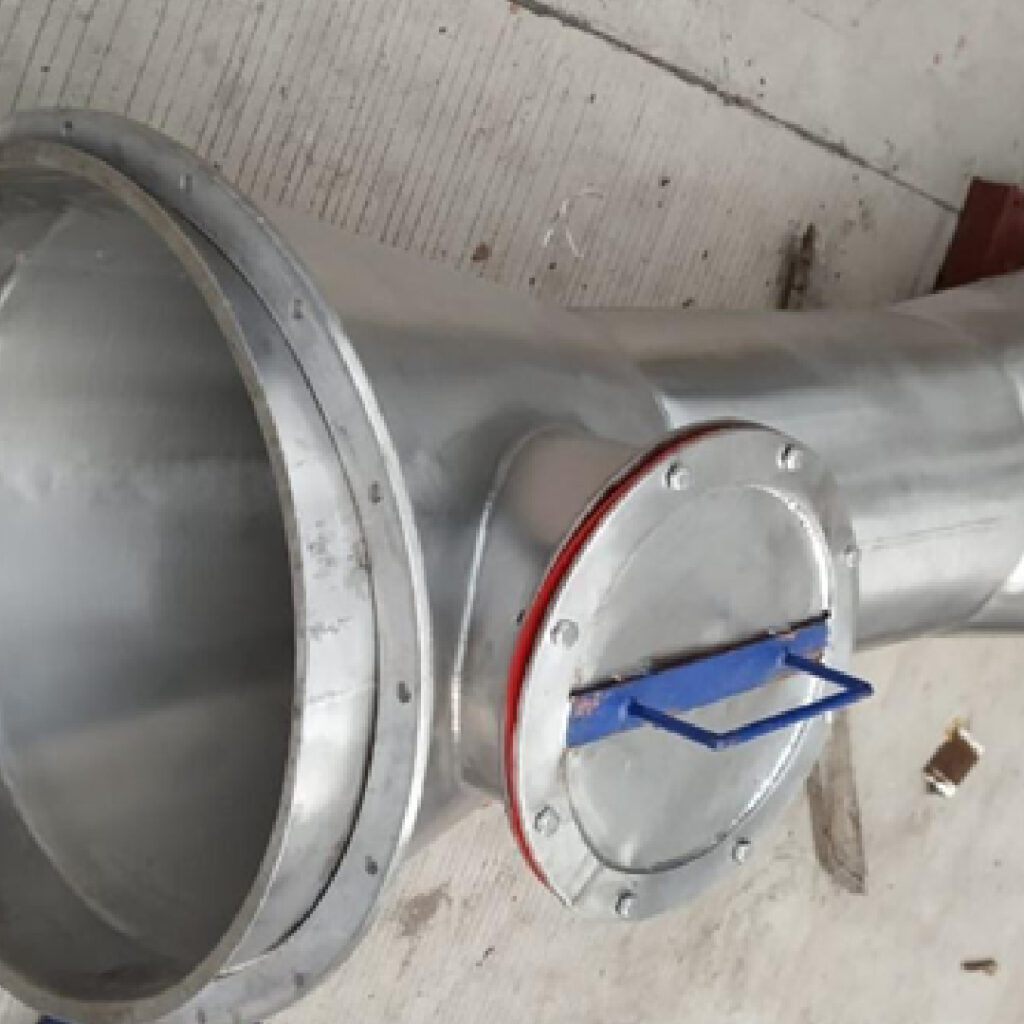
RAYGM CYCLO-VANE SPRAY SCRUBBER
Scrubbing liquid is introduced into the scrubber as a spray directed down over a circular “SwirlScrub Section” arrangement. As the liquid drains through the vanes, it creates curtains of scrubbing liquid. Dust laden gas enters the scrubber tangentially and collides with the curtains initiating particle agglomeration. The coarser particles produced are washed down to the slurry outlet.
Due to cyclonic action of the saturated gas stream as it spins upward forces the agglomerated particles to fall out of suspension. The coarser droplets impinge on the mist eliminator vanes and the finer droplets are forced to drop out of suspension by gravitational and centrifugal forces acting on the gas stream as it exits through the top.
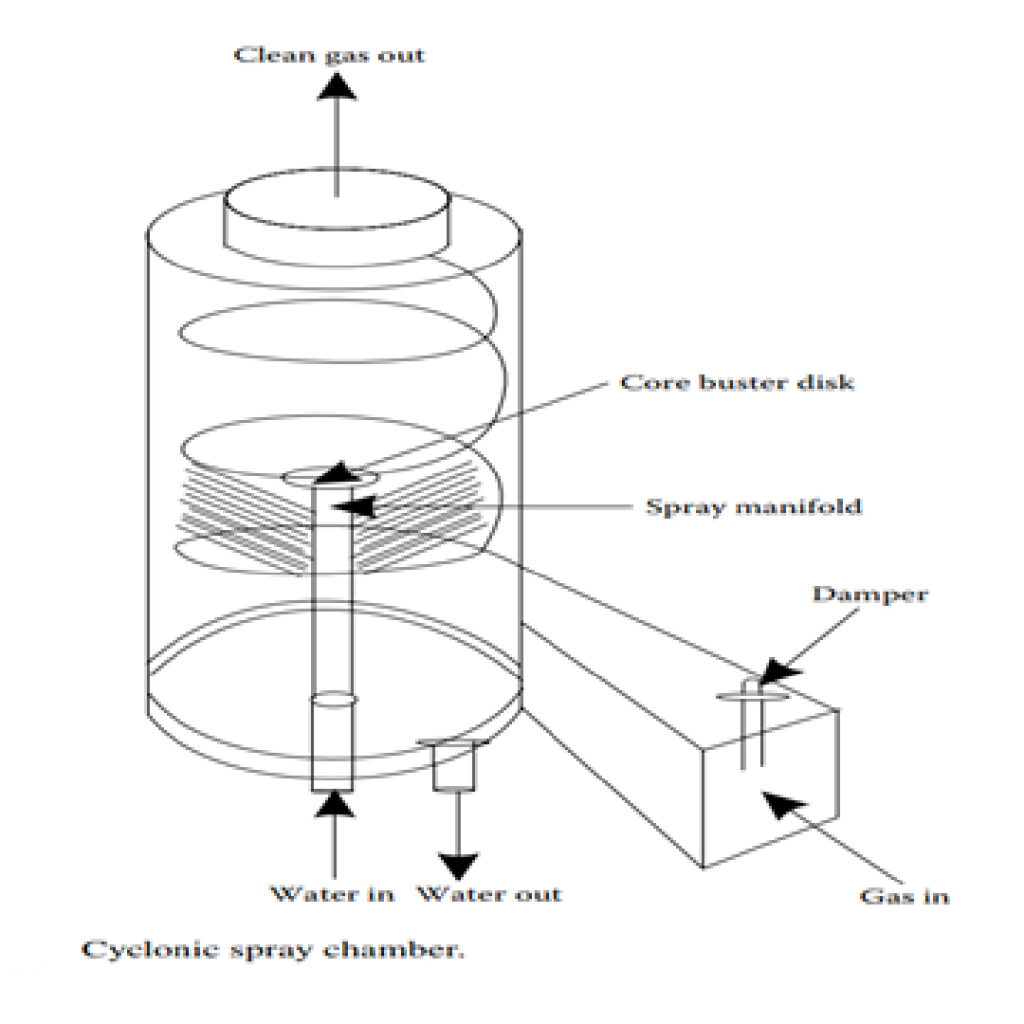
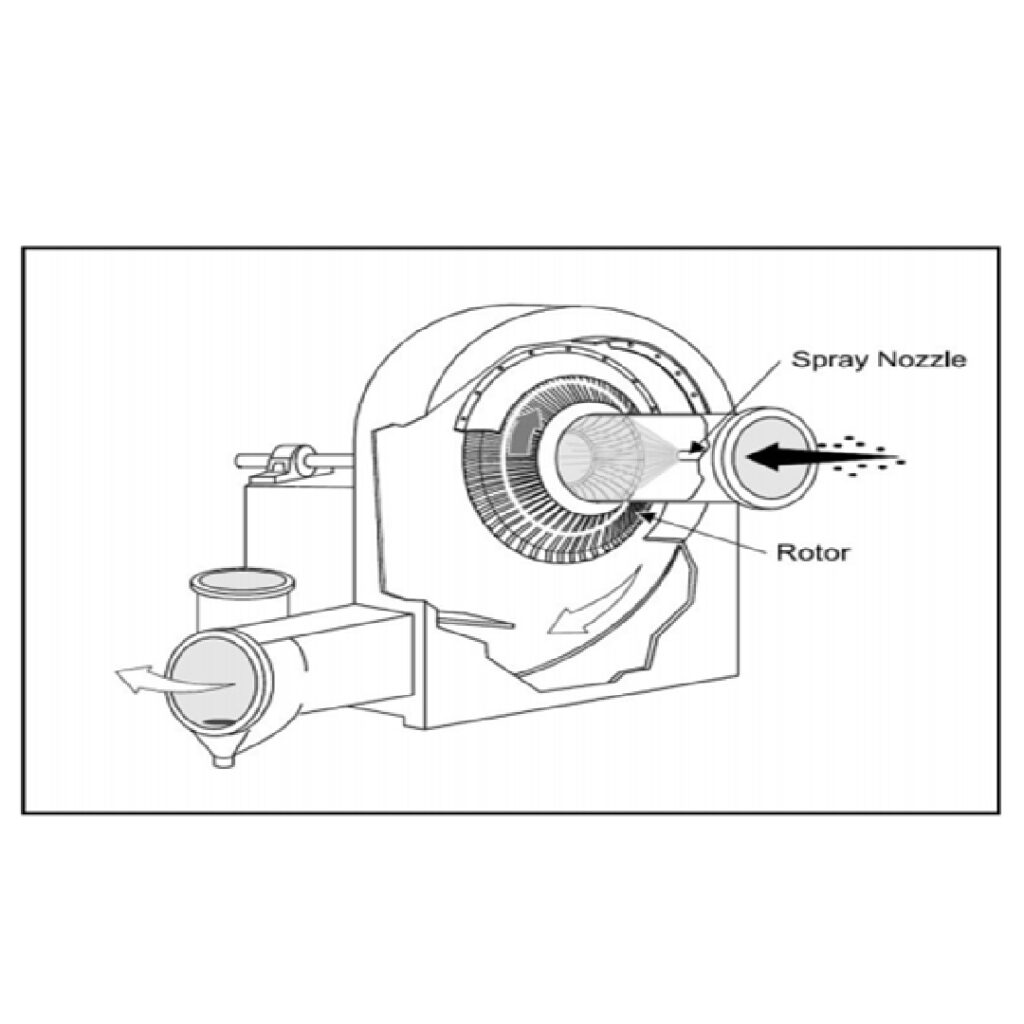
RAYGM DYNAMIC SPRAY SCRUBBER

This is combination of Cyclonic Scrubber and Centrifugal Fan. Dust laden gas enters the lower chamber of the Cyclonic Scrubber tangentially, imparting a cyclonic action to the stream. Coarse particles are removed by a combination of centrifugal and gravitational forces.
The gas stream containing the remaining fine dust is drawn into an adjacent chamber containing a wet- ted fan. Atomized scrubbing liquid is sprayed into the eye of the fan, further reducing droplet size. These droplets encapsulate the fine dust particles, thus enhancing agglomeration.
The gas stream then flows into the upper chamber tangentially at high velocity. The wet agglomerated particles are forced by cyclonic action against the chamber walls and drain down to the internal discharge cone. The gas stream, free of liquid droplets, spins out through an outlet atop the scrubber.
RAYGM VENTURI SCRUBBER
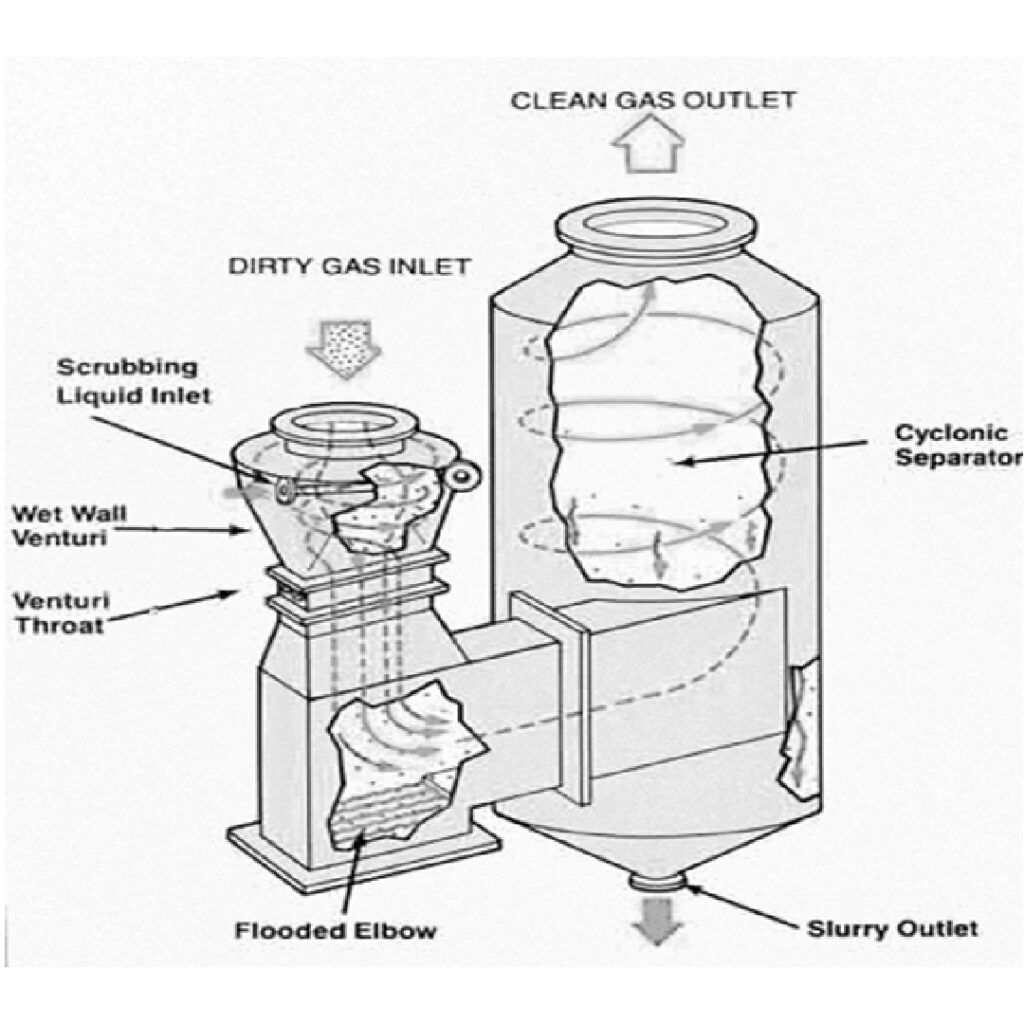
Another popular design from CorroComp is the Venturi scrubber. Venturis are used to collect both particulate and gaseous pollutants, but they are more effective in removing particles than gaseous pollutants.
With Venturi scrubbers, the dirty gas entering a scrubber is forced at high velocity through a Venturi where it collides with scrubbing water. The tiny water droplets capture particles through impaction and diffusion. The mist eliminator for a Venturi scrubber is often a separate device called a cyclonic separator or droplet separator.
The dirty water is then removed in the cyclonic separator and discharged into a recycle tank. Some of the liquid is continuously purged to limit the solids concentration and allow recirculation back to the Venturi section.
RAYGM PACKED SCRUBBER /ABSORPTION TOWER
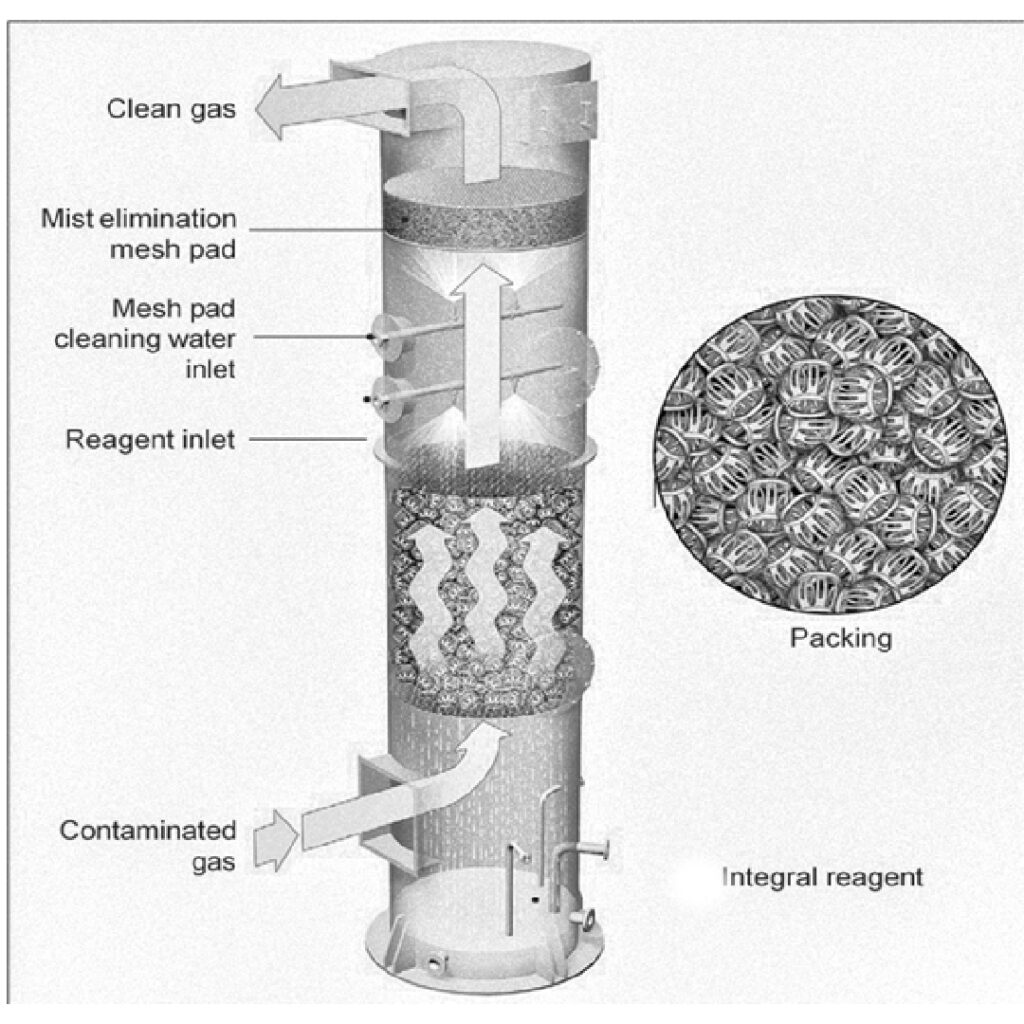
Whether horizontal or vertical, packed-bed wet Scrubbers provide a reliable and practical means of removing acidic and caustic mists and gases from corrosive exhaust streams, with maximum efficiency and minimum pressure loss.
Pollutant laden gases enter at the bottom of the packed tower and rise upward, contacting the scrubbing liquid draining down through the packed column. Since the pollutant concentration decreases as the gas rises, there is constantly fresher solvent available for contact, resulting in an efficient removal of contaminants. Finally, the fine moisture droplets, still suspended in the cleaned gas stream, are removed by a mist eliminator.
Scrub liquid from the eliminator is collected in an integral reservoir and recycled to the tower. Makeup liquid is constantly introduced, and reagent is added on demand using a dosing pump controlled by a pH monitor.
SELF PRIMING SCRUBBERS
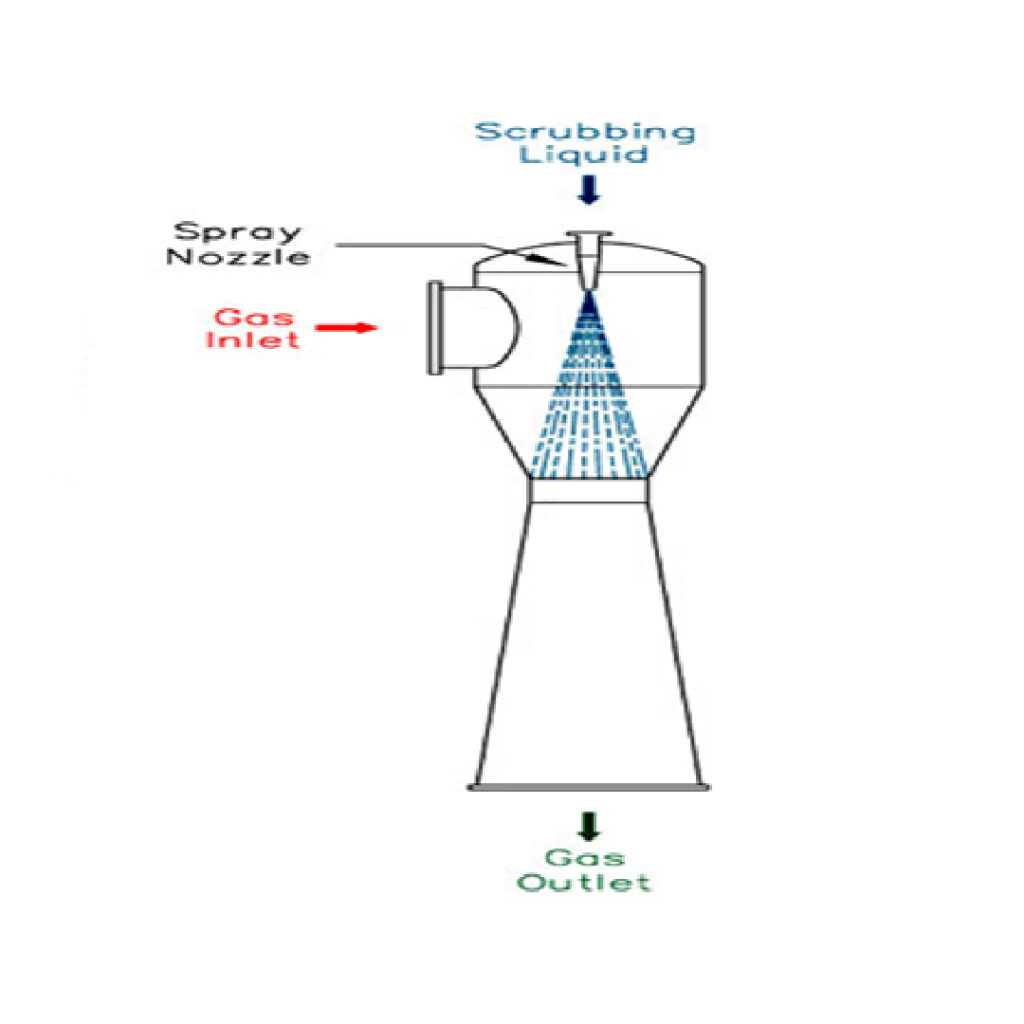
Self-Priming Ventury Scrubbers are designed to remove soluble gases and particulate by inducing a gas flow using high pressure liquid focused into a Ventury throat, which eliminates the need for a separate exhaust fan or blower to transport the contaminated gas stream to the Ventury scrubber. Design incorporates a high-pressure liquid spray for maximum entrainment and scrubbing efficiency, and is the optimal choice where heavy contaminant loads, and corrosive conditions are present with less air present. This provides excellent removal capacities for the reactor systems which needs continuous venting. Like Acid Hydrolysis etc.
Applications of Scrubbers
- Inorganic fumes, vapors, and gases (e.g., chromic acid, hydrogen sulphide, ammonia, chlorides, fluorides, SO2, chlorine gas, hydrochloric acid (HCL).
- Volatile Organic Compounds (VOC)
- Particulate Matter (PM) and Hazardous Air Pollutants (HAP) in particulate form (PMHAP).
- Corrosive air contaminants from processes such as – Hydrogen Bromide, Hydrogen Chloride, Hydrogen Cyanide, Hydrogen Fluoride, Hydrogen Iodide, Hydrogen Selenide, Hydrogen Sulfide
- Aluminum, titanium and other metal machining operations
- Sodium Azide propellant manufacturing and handling
- Pharmaceutical powders and dusts
- Calcium chloride dusts
- Hygroscopic dusts
- Corrosive dusts
- Bulk solids drying process
- Fertilizer Plants
- Odor control in food industries
- Odor Control in Algae Industries
- Odor Control in municipal waste plant.
- Odor control in Wastewater collection and treatment facilities.
- Chemical Industries
- Food / Dairy Industry
- Paper
- Dryer
- Pharmaceutical
- Roofing materials
- Asphalt
- Mining
- Steel
- Brick & Tile
- Fiberglass Insulation
- Power Generation
- Plastic Extrusion
- Ammonia
- Biogas desulphurization, Biogas purification
- Boron Trichloride, Boron Trifluoride
- Chlorine
- Diborane, Dichlorosilane, Dimethylamine
- Ethylene Oxide
- Methyl Bromide
- Methyl Mercaptan, Monomethylamine, Monomethylamine
- NOx
- Phosgene
- Propylene Oxide
- Silicone Tetrachloride, Silicon Tetrafluoride
- Trichlorosilane, Trimethylamine
- Aldehydes and Phenols
- Halogenated organic compounds.

